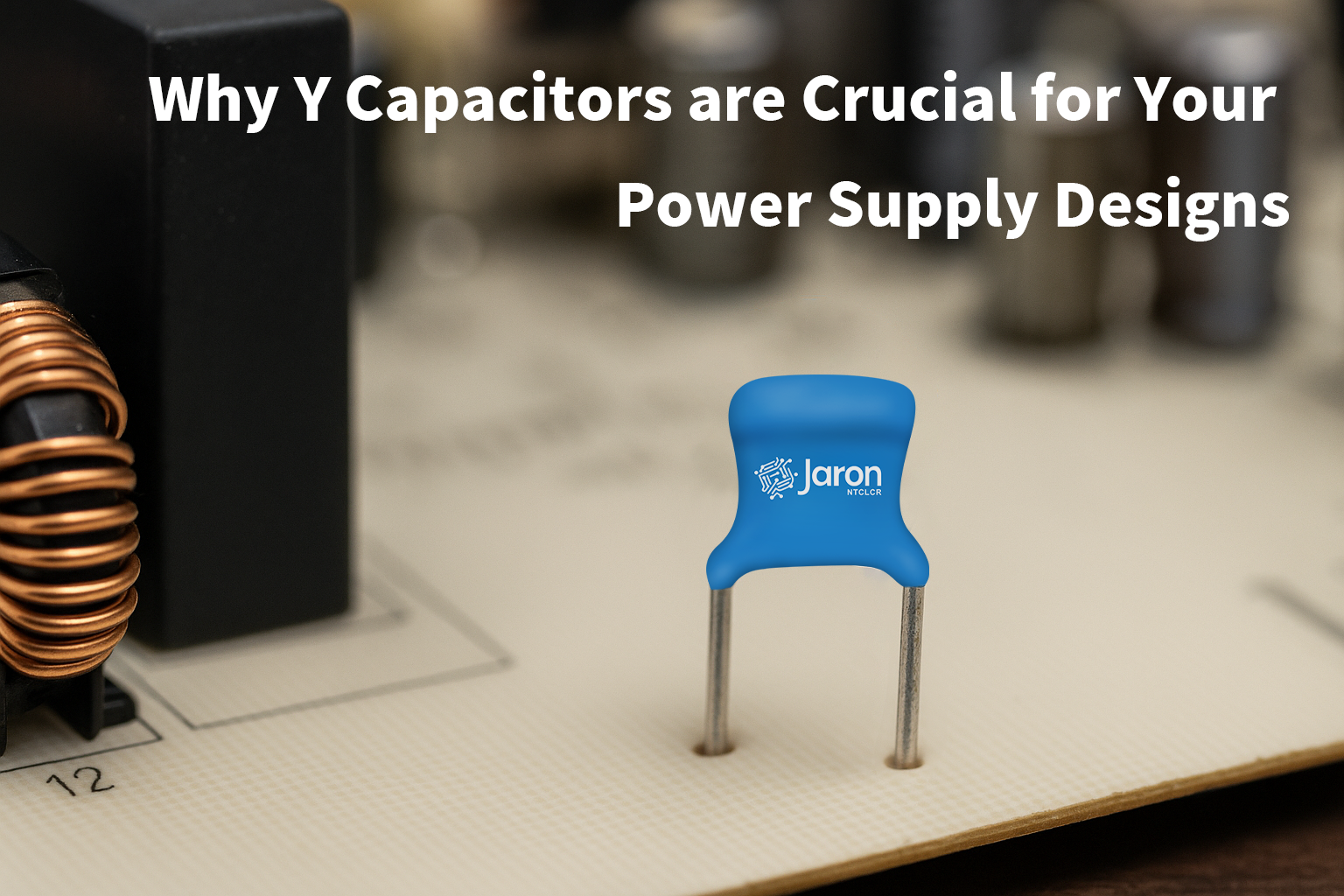A tápfeszültség-stabilitás elismertlen hősei
A Y kondenzátorok kicsik, mégis óriási szerepet játszanak a modern tápegységekben, biztosítva, hogy az eszközök biztonságosan és csendesen működjenek. Ezek az apró alkatrészek csendes őrként működnek, szűrve a magas frekvenciájú zajt, amely zavarhatja az érzékeny elektronikai eszközöket. Ezek nélkül még az alapvető eszközök is zavaró problémákat mutathatnának: egy telefon töltő okozhatja egy laptop képernyőjének villogását, egy mikrohullámú sütő zümmögést bocsáthat ki, vagy egy okos hangszóró hirtelen megszakíthatja a lejátszást közepén. Ebben a bejegyzésben bemutatjuk funkcióikat, alkalmazásaikat és azt, miért nélkülözhetetlenek azok számára, akik megbízható tápellátási rendszereket terveznek.
A Y-kondenzátorok lényege, hogy zajokat nyelnek el, és kritikus biztonsági funkciót látnak el. A hagyományos kondenzátoroktól eltérően, amelyek kizárólag az energia tárolására koncentrálnak, ezek az alkatrészek az indiszkrét elektromos interferencia elterelésére specializálódtak. Amikor elektromágneses zavar (EMI) – apró feszültségcsúcsok, amelyeket például közeli motorok, rádiójelek vagy akár más eszközök is keltenek – megpróbál bejutni egy áramkörbe, a Y-kondenzátorok szabályozott áramkörutat biztosítanak a föld felé. Ez az átirányítás megakadályozza, hogy a zaj terjedjen a rendszeren belül, ezzel biztosítva az eszköz teljesítményét és a felhasználói élményt is.
Elnevezés, Kialakítás és Működési elv
A „Y” a nevükben a biztonságukat igazoló vizsgálati elektródák egyedi elrendezéséből ered, ez a megjelölés hangsúlyozza specializált felhasználásukat. Az élő áramkörök (például a hálózati feszültségű vezeték) és a földelés között elhelyezkedve, az Y kondenzátorok akadályt képeznek a szórt elektromos jelekkel szemben. Képzeljünk el egy forgalmas autópályát, ahol az EMI egy felelőtlen sofőr; az Y kondenzátor hasonlóan egy külön lehajtóhoz, amely biztonságosan eltéríti a zavarjeleket a kritikus alkatrészek útjából, mielőtt káoszt okozhatnának.
Ez a zavar többféle formában is jelentkezhet: elektromágneses impulzusok a közeli háztartási készülékekből, statikus elektromosság, vagy akár feszültségingadozások az elektromos hálózatból. Az ilyen feszültségcsúcsok elnyelésével és elvezetésével az Y kondenzátorok biztosítják, hogy a kényes mikrochipek, érzékelők és kijelzőmodulok folyamatosan tiszta áramot kapjanak. Ennek a stabilitásnak köszönhető, hogy a laptop nem szakad meg vihar idején, vagy hogy egy intelligens termosztát pontos méréseket végezhet akkor is, amikor más eszközök ugyanabban a térben vesznek fel áramot.
Biztonsági szabványok: Elengedhetetlen szabályozás
Az Y kondenzátorok nemcsak funkcionálisak – hanem szigorúan szabályozottak is. Szervezetek, mint az International Electrotechnical Commission (IEC) és az Underwriters Laboratories (UL), szigorú szabályokat írnak elő ezek tervezésére és teljesítményére. Ezek a szabályok előírják, hogy az Y kondenzátorok ellenálljanak hirtelen feszültségcsúcsoknak, magas hőmérsékleteknek és hosszú idejű használatnak veszélyes áramszivárgás nélkül.
Ezeknek az előírásoknak való megfelelés érdekében az Y kondenzátorokon olyan szigorú teszteket végeznek, amelyek másodpercek alatt tönkretennének egy átlagos kondenzátort. Például feszültségcsúcsoknak, extrém páratartalomnak és hőmérsékletváltozásnak vetik alá őket, amelyek hosszú évekig tartó használatot szimulálnak. Ezeknek a teszteknek a teljesítése nem csupán formaság – hanem előfeltétele a globális piacokra jutásnak. Egy IEC vagy UL tanúsítvánnyal rendelkező eszköz azt jelzi a fogyasztók számára, hogy a gyártás során a biztonságot prioritásként kezelték – ez a bizalom közvetlenül átcsapódik a márkahűségbe.
Hol rejtőznek az Y-kondenzátorok a mindennapi életben
Az Y-kondenzátorok mindenütt jelen vannak a modern elektronikában, bár ritkán tűnnek fel. Nézzen bele egy asztali számítógép tápegységébe, és megtalálja őket a bemeneti csatlakozók közelében, ahol csillapítják a hálózati zajt. A televíziókban az EMI-t akadályozzák meg, amely elmosódhatja a 4K kép élességét. Még háztartási készülékek, mint a mikrohullámú sütők és a turmixgépek is rájuk támaszkodnak, hogy elkerüljék az ugyanazon áramkör más eszközökkel való zavarását.
Az Y-kondenzátorok fontossága nem korlátozódik a háztartásokra; az ipari környezetekben is kritikus szerepet játszanak. Gyári berendezések, például robotkarok és szállítószalagok pontosságát biztosítják – egyetlen EMI-ugrás is elvétheti egy érzékelő működését, leállítva a termelést. Az egészségügyben, például szívmonitorok és MRI-készülékek is Y-kondenzátorokra támaszkodnak, hogy megszakítás nélküli, pontos működést biztosítsanak, ahol egy rövid hiba is életveszélyes következményekkel járhat.
Az Y-kondenzátorok jövője az egyre fejlődő technológiában
Ahogy a technológia fejlődik, a kisebb méretű, hatékonyabb tápegységek iránti igény is növekszik – az Y-kondenzátorok pedig lépést tartanak ezzel a fejlődéssel. A következő generációs kialakítások olyan nagy minőségű kerámi anyagokat használnak, amelyek kisebb szivárgóáramot biztosítanak, így alkalmasak vékonyabb eszközökbe, mint például hajtható okostelefonok és viselhető fitnesz-nyomon követők. A szűkebb tűrések és a javított hőállóság lehetővé teszi, hogy megbízhatóan működjenek a magasabb feszültségek és gyorsabb feldolgozási sebességek mellett, amelyek az új technológiák, például az 5G infrastruktúra és az elektromos járművek világában jellemzőek.
A gyártók számára ezeknek az új generációs Y-kondenzátoroknak az alkalmazása nem csupán a jelenlegi szabványok teljesítéséről szól; ez a termékek jövőbiztonságának biztosításáról is szól. Ahogy a fogyasztók egyre inkább a biztonságra, az energiatakarékosságra és a megbízhatóságra helyezik a hangsúlyt, azok az eszközök, amelyek legkorszerűbb Y-kondenzátorokkal vannak felszerelve, ki fognak emelkedni a zsúfolt piaci kínálatból. Az időben történő bevezetés emellett lehetővé teszi a vállalatok számára, hogy megfeleljenek a jövőbeli szabályozásoknak, elkerülve ezzel költséges újratervezéseket később.
Összegzés: Miért nélkülözhetetlenek az Y-kondenzátorok
A tápegység-tervezés bonyolult ökoszisztémájában az Y-kondenzátorok ugyan kicsik, de hatásuk óriási. Ezek szűrik ki a zajt, védelmet nyújtanak az elektromos veszélyek ellen, és biztosítják a globális biztonsági szabványoknak való megfelelést – mindemellett lehetővé teszik a mindennapokban használt eszközök zavartalan működését. Az mérnökök számára kihagyni őket nem opció; ez egy olyan kompromisszum, amely teljesítményproblémákat, biztonsági előírások megsértését és az ügyfélbizalom csökkenését eredményezheti.
A háztartási készülékektől a életmentő orvosi felszerelésekig, az Y-kondenzátorok azok a hallgatag hősök, akik biztosítják, hogy az áram tisztán, csendesen és biztonságosan folyjon. Ahogy a technológia egyre fejlődik, szerepük csak még kritikusabbá válik. Mindenki számára, aki tápegységeket tervez, a minőségi Y-kondenzátorok integrálása továbbra is az egyik legegyszerűbb, ugyanakkor leghatékonyabb módja annak, hogy megbízható, előírásoknak megfelelő és a fogyasztók által megbecsült termékeket lehessen kínálni világszerte.
Tartalomjegyzék
- A tápfeszültség-stabilitás elismertlen hősei
- Elnevezés, Kialakítás és Működési elv
- Biztonsági szabványok: Elengedhetetlen szabályozás
- Hol rejtőznek az Y-kondenzátorok a mindennapi életben
- Az Y-kondenzátorok jövője az egyre fejlődő technológiában
- Összegzés: Miért nélkülözhetetlenek az Y-kondenzátorok

